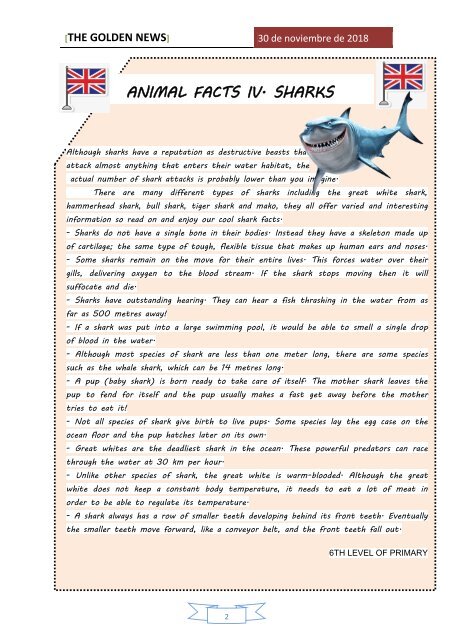THE GOLDEN NEWS. Nº 09. 2018/2019
You also want an ePaper? Increase the reach of your titles
YUMPU automatically turns print PDFs into web optimized ePapers that Google loves.
[<strong>THE</strong> <strong>GOLDEN</strong> <strong>NEWS</strong>] 30 de noviembre de <strong>2018</strong><br />
ANIMAL FACTS IV. SHARKS<br />
Although sharks have a reputation as destructive beasts that<br />
attack almost anything that enters their water habitat, the<br />
actual number of shark attacks is probably lower than you imagine.<br />
There are many different types of sharks including the great white shark,<br />
hammerhead shark, bull shark, tiger shark and mako, they all offer varied and interesting<br />
information so read on and enjoy our cool shark facts.<br />
- Sharks do not have a single bone in their bodies. Instead they have a skeleton made up<br />
of cartilage; the same type of tough, flexible tissue that makes up human ears and noses.<br />
- Some sharks remain on the move for their entire lives. This forces water over their<br />
gills, delivering oxygen to the blood stream. If the shark stops moving then it will<br />
suffocate and die.<br />
- Sharks have outstanding hearing. They can hear a fish thrashing in the water from as<br />
far as 500 metres away!<br />
- If a shark was put into a large swimming pool, it would be able to smell a single drop<br />
of blood in the water.<br />
- Although most species of shark are less than one meter long, there are some species<br />
such as the whale shark, which can be 14 metres long.<br />
- A pup (baby shark) is born ready to take care of itself. The mother shark leaves the<br />
pup to fend for itself and the pup usually makes a fast get away before the mother<br />
tries to eat it!<br />
- Not all species of shark give birth to live pups. Some species lay the egg case on the<br />
ocean floor and the pup hatches later on its own.<br />
- Great whites are the deadliest shark in the ocean. These powerful predators can race<br />
through the water at 30 km per hour.<br />
- Unlike other species of shark, the great white is warm-blooded. Although the great<br />
white does not keep a constant body temperature, it needs to eat a lot of meat in<br />
order to be able to regulate its temperature.<br />
- A shark always has a row of smaller teeth developing behind its front teeth. Eventually<br />
the smaller teeth move forward, like a conveyor belt, and the front teeth fall out.<br />
6TH LEVEL OF PRIMARY<br />
2

















